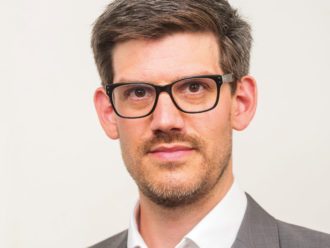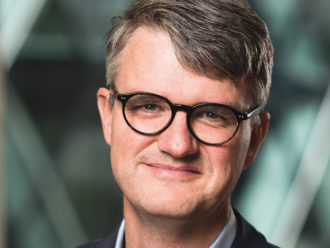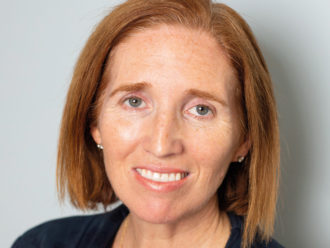How have your first two years at the HSBC Pension Scheme been?
It was interesting joining during lockdown because you do not get to meet the people you work with in a real life face-to face basis. But it has been a busy time. HSBC is a big UK scheme and there is a lot going on. When joining a new organisation, there is always certain stuff you have to learn. For example, publishing the annual TCFD [Task Force on Climate-related Financial Disclosures] statement is quite an onerous task that is completely new to me.
I was previously a pensions director at Santander UK and that helped me prepare for this role. It helped me understand the peculiarities of bank governance and oversight of pension schemes within a banking organisation, given the implications for bank capital if a pension scheme is in actuarial deficit or a near breakeven position.
In terms of the bank itself, HSBC is a great place to be. It is a global bank with lots of good people, a great trustee board and lots of interesting stuff to do. So, the past two years have gone by quickly.
As chief investment officer, you are responsible for the day-to-day oversight of the investment strategy for the defined benefit (DB) and defined contribution (DC) sections. Do these strategies overlap? We don’t talk of them as sections because they are not sections but DB and DC assets. The DB scheme is closed, so the existing employed members continue to save for their retirement through the DC scheme. So, depending on how long you have worked with us, you could have a DB and DC pension.
Fundamentally, the same underlying philosophy and performance strategies guide the investment strategy. That includes issues such as a belief in diversification, the persistence of smart beta strategies and a focus on ESG risk mitigation,including climate risk. But given the different profiles of DB and DC assets, there are differences in strategy.
The DB scheme sits on a healthy surplus. How does that impact your investment strategy?
The DB scheme is well funded, so that plan is largely de-risked in terms of its asset allocation. Its assets are typically a mixture of high-quality credit and government securities with a small allocation to illiquid assets.
Effectively, it is hedged against interest rate and inflation risks and is focussed on our cashflow-driven investment strategy.
We have a 44% allocation to high-quality credit, 47% to government securities and 9% to illiquid assets, which are traditionalprivate equity assets, including renewables such as solar power.
What does your DC allocation look like?
The DC strategy is quite different. It is a typical standard offering of several default strategies which members are signed up to if they do not choose their own investments. For the HSBC scheme, there are three default strategies, depending on what members want to do with their pension savings at retirement.
We have a default strategy for income drawdown, one for a cash lumpsum and one to buy an annuity, which, of course, members no longer need to convert their pension savings into a lifetime income, so this option is less central to members than it may previously have been.
Effectively, each of those default strategies will go through an accumulation phase where younger members are exposed to riskier and more growth-oriented assets, such as equities. As they approach retirement, they move to the consolidation phase which means progressively implementing higher allocations to diversified growth funds and fixed income, which is fairly standard.
The de-risking phase begins about 20 years from retirement, so it is a gradual process to move people to less riskier assets. It is not done over a concentrated period of time so that we dilute market risk across that consolidation phase.
One interesting point is the global equity exposure in the default growth phase. It is invested in the Future World fund, a global equity strategy provided by Legal & General Investment Management. This strategy was seeded by the HSBC Bank (UK) Pension Scheme in 2015.
It is not a traditional index. It also embeds climate risk reduction targets such as greenhouse gas emission reductions, higher exposure to green revenues and less exposure to companies relying on thermal coal as a revenue source, compared with a standard market capitalisation-weighted global equity index within the asset allocation. For example, the fund explicitly tries to mitigate climate change.
The DC scheme has about £6.7bn in assets under management and the Future World fund holds £4bn of those total assets, so it is a material allocation. It has to deliver reductions in carbon emissions, so it excludes companies that generate 30% or more of their revenue from coal extraction or coal power and excludes controversial weapons.
So, it is an example of ESG characteristics being built into a fund that is not overtly labelled as an ESG fund. We are getting more and more questions from our members on which funds are ESG friendly and which are best for climate. Building ESG risk mitigation, including climate risk into our fund offerings to members is business as usual now. We are aiming for all portfolios we invest in to have ESG characteristics embedded in their strategy and the asset managers engaging with underlying investee companies to improve ESG risk management.
Do you plan to broaden the investment strategy of the DC fund to include illiquid assets?
That’s an interesting question. This is a relatively new topic, but it has been gaining traction. Future investment returns from traditional asset classes are now generally expected to be lower than in the recent past due to the impact of quantitative easing and monetary tightening on asset values.
We have been trying to understand if there is a benefit to members in terms of risk-adjusted returns from introducing illiquid assets to our existing default strategies. It is a research project for the moment. There are quite a number of challenges to think about before we make a real commitment.
As far as we are concerned, the big questions are how to structure such assets within the overall liquidity mix to provide genuine diversification and to mitigate their impact on being able to provide daily liquidity to members. During Covid, a lot of property funds had to close to investments and redemptions because those funds could not be accurately priced.
That gating issue is a real one. You do not want to have people looking to retire not being able to access their savings. So, there are structural questions you need to think about.
What other issues do you face when deciding if to include illiquids in your DC portfolio?
A related issue with illiquid investments is that they do not normally price daily. So, you have an issue making sure members are transacting based on fair prices. You also need to have an operational process to manage cashflows and drawdown requests, which can be challenging depending on what resources you have.
A lot of these illiquid asset classes have contractual illiquidity, maybe 10 or 20 years in the case of infrastructure. So, you have to be comfortable that that contractual illiquidity fits with the age profile of your membership.
Then there is the question of inter-generational fairness, which is a big issue for our trustees. The J curve in private equity returns means members who invest in the early years tend to get a negative return. They are investing for a number of years before investments mature and are realised, paying investment returns back to investors.
You can imagine a situation where the J curve will have a negative impact for members who are invested in the early years but retire before the investment returns are realised. Other members are there for the lifespan of these assets and then reap the rewards at the end. So, the question is: how do you build these assets in to your portfolio whilst trying to mitigate those different return impacts on different members.
And the last one, which is important, is to achieve the diversification that illiquid asset classes tend to show in portfolio modelling. This is influenced by them not pricing daily and, therefore, are not subject to the up and down volatility that daily markets tend to exhibit.
So, some of that perceived diversification can be modelled diversification, as opposed to genuine underlying economic diversification. In other words, are you really investing in different types of companies than you would in the listed space to get real diversification?
So, you need to be clear that you are getting real economic diversification. There is a prevalence now for companies to stay in private markets for longer than they are used to, with some not listing at all.
You are seeing different types of companies in listed or unlisted markets. If you are going to do this, it is important to work with your listed equity manager to ensure that your unlisted or alternatives manager builds a portfolio that is different and complements the listed exposure. It is all those structural questions and questions of design that trustees need to get comfortable with before you embark on that strategy. And that is where we are right now.
Moving on to another topic, you have announced a commitment to a net-zero target. How are you implementing that?
This is a huge topic. We are using the IIGCC [Institutional Investor Group on Climate Change] net zero investment framework to frame how we approach this question. It is widely accepted as best practice among institutional investors.
We are using it to design our climate dashboard and understand what metrics we should be using.
What does that mean in practice?
HSBC’s focus is on reducing real economic emissions. What we mean by that is the trustee will not be immediately selling high emitting stocks to reduce the carbon footprint of their portfolio. What we want to do is reduce real economic emissions over time.
Just selling the stocks makes it somebody else’s problem. Instead, we want to work with companies to continue to provide capital to help them on that decarbonisation journey.
In practice, that means we are building a framework portfolio by portfolio to identify which companies are high emitters and then understand what the asset managers are doing with those companies.
Taking a step back. The HSBC scheme is an outsourced model with asset management being provided by third party asset managers. We do not manage in-house; it is all managed externally. So, we built this management information framework to identify highly emitting companies based on emissions data, which is by definition backward looking.
But we try to be forward looking as well to understand the extent to which these companies are aligned with the Paris Agreement and then have our asset managers monitor the progress that those companies have made on the journey towards net zero.
We do not engage with the companies themselves; we allow the asset manager to do that. But that means we need good management information that tells us which companies are of interest, what their decarbonisation path is and are they aligned to a net-zero target? If not, that would be a red flag, so we would have to speak to the asset manager to engage with them. We would then use that lever of engagement with asset managers to push change throughout the value chain, not just with the companies themselves.
That sounds easy to do but is actually fraught with complexity. Incomplete information is one reason there is only partial coverage of emissions data from underlying corporates. When you look at that data to see who is actually aligned with the goals of the Paris Agreement, there are no widely accepted metrics in the industry so that is challenging to do.
Setting a 2050 carbon reduction target has become an increasingly popular strategy. Isn’t this just a case of kicking the can down the road?
We set interim targets for our listed equity and corporate assets to be fully aligned with the goals of the Paris Agreement. Obviously, that boils down to engagement with underlying companies, but we recognise that we need to implement these goals now. April’s Intergovernmental Panel on Climate Change report suggested that we need to get greenhouse gas emissions to peak in the
next few years. So, we are actively engaging with asset managers on that.
One of our advisers – Lane Clark & Peacock – have stopped recommending managers if they have not signed up to the Net Zero Asset Managers Initiative. So, there is pressure on asset managers from asset owners, regulators and investment consultants. The impression I get when speaking to asset managers is that change is happening.
We have been publishing them since 2018 and year on year the data coverage is getting better and we generally see the weighted average carbon intensity of emissions is dropping. Whether it is dropping in line with 2050 targets is a more complicated question, but progress appears to be happening, although it is early days and trends are complicated by the data issues I referred to earlier.
What does this mean for your fixed income strategy, given that the DB fund is bond heavy?
The short answer to that question is: all of the above, except we don’t have a vote at AGMs. The process of identifying highly-emitting companies and their alignment with the Paris Agreement is still there. And we encourage our bond fund managers to work with those companies to bring carbon emissions down.
Companies need capital, in the form of debt and equity, and the managers I speak to assure me they are getting access to senior executives to drive home this point about net zero. We are now getting examples of bond fund managers selling holdings that are not aligned with the Paris Agreement. I do not want to overstate that, it is just an example, but it is not something I have seen before. That says to me, this is hitting home, this is real, asset managers are listening.
Fundamentally, it is not a debt or equity argument, but a company argument. They need to exhibit certain behaviours in order to attract capital to sustain their business model and, as long-term investors, we want to see and invest in sustainable business models.
You sound quite hopeful there.
I would like to think I am a hopeful person, but we all need to recognise the scale of the challenges.





Comments